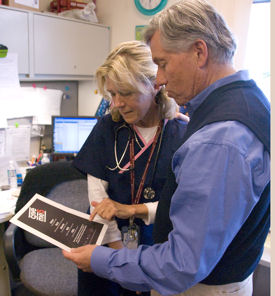ACP tackles timeless themes in contemporary circumstances
Historical perspectives written at varying times over the College's 93 years.
Over the upcoming year, I will have the good fortune of representing the American College of Physicians in a variety of venues in this country and abroad. To prepare, I reviewed some of the historical perspectives written at varying times over the College's 93 years (see sidebar). A portion of these accounts were authored by two of my predecessors.
While the issues the College has addressed appear timeless, its responses have been novel. Themes have often been revisited since the College's inception in 1915, each iteration crafted to respond to new national developments and changing generational perspectives. In subsequent columns, I will examine some of the major themes, reviewing their history and summarizing ACP's current approaches to them. For now, however, this introduction will provide an overview.
On the College's 75th anniversary, President-elect Nicholas E. Davies, MACP, asked the membership: “What do you believe to be the five most important issues facing American health care?” In that year, 1990, the responses were cost, bureaucracy, access, technology and tort reform. Does this sound familiar?
Today, in the College's 93rd year, those timeless themes reemerge but contemporary circumstances necessitate new solutions. How can a nation spend more on health care than any other industrialized country yet have poorer outcomes on multiple metrics? How can 47 million of its citizens remain uninsured and over 300 million of its citizens have access to health care with such variable quality?
What is an internist and how do we encourage more young people to become one? How do we deal with the disparity in earnings between primary care physicians and physicians in other fields when all of our livelihoods are dictated, in large measure, by a formula as seemingly capricious as the sustainable growth rate?
The patient-centered medical home (PCMH), proposed by the College and supported now by over 100 other medical, non-governmental and governmental organizations, arguably could become the most significant change in the delivery of health care since the introduction of Medicare. How does ACP help ensure that the many PCMH pilot projects emphasize quality as well as costs?
Our diverse physician workforce has diverse needs. How do we address the career and lifestyle needs of men, women, minorities and international medical graduates? How do we make the College so relevant to their needs that they see membership as essential? How do we best respond to the requests of members who live in 124 countries outside of the U.S.?
What is the appropriate relationship between ACP and the American Board of Internal Medicine? How do we work with all major internal medicine organizations to help produce the best educated physicians, a process for staying current that physicians will welcome, and health care that is uniformly good and universally available?
As the College approaches its 100th year, some of the recurring themes outlined above seem particularly daunting. Dealing with them will require frank and open discussions with our members and with other stakeholders.
Experience in this country and that of other nations suggests that patients favor longitudinal, patient-centered care. Patient-centered care also holds promise as an evidence-based means of controlling rising health care costs. Internal medicine is a cornerstone of this delivery system. It must thrive. Internists, whether pursuing careers as generalists, subspecialists or hospitalists, are interdependent. They have a common background, should maintain a core of knowledge, and should recognize their symbiotic need for one another.
Dealing with today's challenging themes will also require close collaboration between the College and other internal medicine stakeholders. If our endeavors are to be collegial and productive, all organizations must have transparent decision-making processes and readily accessible policy. Compromise must be principled.
The College, ideally with all internal medicine organizations and other primary care societies as its partners, must also address these themes in a forthright manner with other medical specialties, Congress, public regulators, employers and payers. An aging nation consuming unfathomable sums for chronic illness is unsustainable. Health care in which patients have one physician for every organ system is unaffordable. Permitting the collapse of primary care is unimaginable.
Successful delivery of health care requires the availability of every field of medicine. The issue, though, is what proportion of a nation's physician workforce each specialty and subspecialty should constitute.
Society can dictate these outcomes by matching the number of residencies to the need. However, it must also recognize that if it wishes to create a greater supply of young people filling the ranks of certain fields of medicine, it must create a greater demand for those residencies. Prospects for future earnings affect new physicians' career choices after medical school. Greater parity of earnings will help ensure that medical students pursue careers for their intellectual appeal and sense of fulfillment rather than to repay their educational debt or attain a reasonable lifestyle.
Prudent expenditure of health care resources requires health information technology that links all the participants in a patient's individualized care. It holds promise for savings by eliminating duplication of labs and procedures and lessening the potential for error. If compensation is to be linked to performance measures, rewards must accurately reflect the degree of difficulty of evidence-based metrics across all fields.
An orthopedist operating on the correct limb presents about the same degree of difficulty as an internist placing his stethoscope in his ears rather than his nostrils. Payers must help encourage physicians to care for the underserved by recognizing that performance measures are associated with greater barriers in an impoverished population than in a more affluent one, and by scaling targets accordingly.
Rigorous efforts are being made to define performance measures for procedures and treatments of proven benefit. Impartial observers should apply equal vigor to define procedures and treatments with little evidence of benefit. Inappropriate or wasteful testing must be discouraged.
These are some of the issues with which the College will be dealing and some of the methods it will be exploring in the upcoming year and beyond. I look forward to having the opportunity to address them. Representing the American College of Physicians as its President always has been an honor; having the good fortune of filling that role this year promises to be a remarkable experience.
While the challenges we face are timeless, contemporary circumstances necessitate new approaches. I am confident that the American College of Physicians, as it has done countless times over its 93 years, will rise to the occasion.




